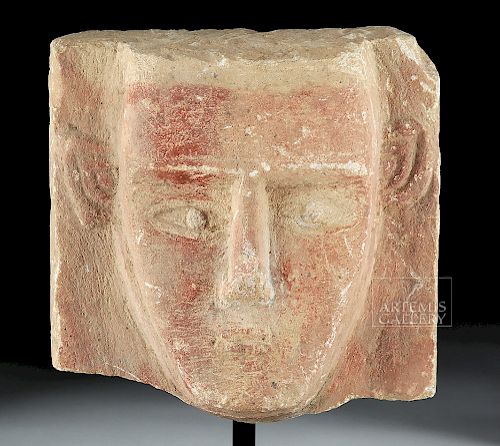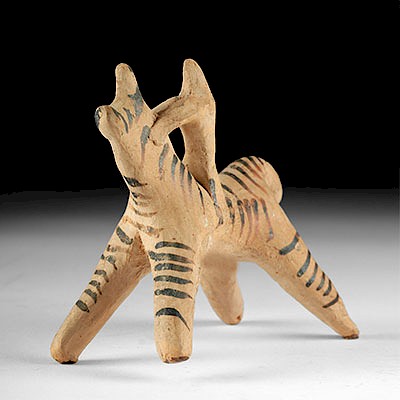Ancient South Arabian Stone Funerary Plaque - Face
Lot 119
About Seller
Artemis Gallery
686 S Taylor Ave, Ste 106
Louisville, CO 80027
United States
Selling antiquities, ancient and ethnographic art online since 1993, Artemis Gallery specializes in Classical Antiquities (Egyptian, Greek, Roman, Near Eastern), Asian, Pre-Columbian, African / Tribal / Oceanographic art. Our extensive inventory includes pottery, stone, metal, wood, glass and textil...Read more
Estimate:
$3,400 - $5,100
Absentee vs Live bid
Two ways to bid:
- Leave a max absentee bid and the platform will bid on your behalf up to your maximum bid during the live auction.
- Bid live during the auction and your bids will be submitted real-time to the auctioneer.
Bid Increments
| Price | Bid Increment |
|---|---|
| $0 | $25 |
| $300 | $50 |
| $1,000 | $100 |
| $2,000 | $250 |
| $5,000 | $500 |
| $10,000 | $1,000 |
| $20,000 | $2,500 |
| $50,000 | $5,000 |
| $100,000 | $10,000 |
| $200,000 | $20,000 |
About Auction
By Artemis Gallery
Oct 25, 2018
Set Reminder
2018-10-25 11:00:00
2018-10-25 11:00:00
America/New_York
Bidsquare
Bidsquare : Antiquities from Egypt, Greece, Italy, Asia
https://www.bidsquare.com/auctions/artemis-gallery/antiquities-from-egypt-greece-italy-asia-3538
Featuring Egyptian, Greek, Roman, Etruscan, Near Eastern, plus Asian art from Central and Far East. If you love the classics, this is the sale for you. Artemis Gallery info@artemisgallery.com
Featuring Egyptian, Greek, Roman, Etruscan, Near Eastern, plus Asian art from Central and Far East. If you love the classics, this is the sale for you. Artemis Gallery info@artemisgallery.com
- Lot Description
South Arabia, Yemen, Kingdom of Qataban, ca. 1st millennium BCE. A pale brown limestone slab carved into a high-relief stelae, with an abstract face presenting a triangular nose, deep set oval eyes, a small mouth, a prominent brow ridge, well-groomed eyebrows, and the suggestion of a crown or headdress. Unusually for these stelae, this example also has ears. At one time, this figure would have had inset eyes with pupils made of shell or some other soft material. This example has what appears to be red pigment on much of its surface. The full stelae would have had an inscription in the ancient Yemeni alphabet. Size: 7.9" W x 7.5" H (20.1 cm x 19 cm); 10.5" H (26.7 cm) on included custom stand.
The deceased in this part of the world were often represented by anthropomorphic funerary stelae like this one; however, the face is highly stylized and it is doubtful that this is a portrait of a known individual. They have been found in three areas, one of which was the cemetery at Tamna, the capital city of Qataban. The Kingdom of Qataban rose to prominence in the second half of the 1st millennium BCE, because it controlled the trade in frankincense and myrrh, incenses required to be burned at altars during religious rituals further north and west. A haunting and rare artifact, certain to spark conversation, and a reminder of the deeper history of the Middle East.
Provenance: private East Coast, USA collection
All items legal to buy/sell under U.S. Statute covering cultural patrimony Code 2600, CHAPTER 14, and are guaranteed to be as described or your money back.
A Certificate of Authenticity will accompany all winning bids.
We ship worldwide and handle all shipping in-house for your convenience.
#133290Piece is a fragment of a larger stelae. Expected scratching on surface. Nicely preserved features and pigment.Condition
- Shipping Info
-
All shipping is handled in-house for your convenience. Your invoice from Artemis Gallery will include shipping calculation instructions. If in doubt, please inquire BEFORE bidding for estimated shipping costs for individual items.
-
- Buyer's Premium



 EUR
EUR CAD
CAD AUD
AUD GBP
GBP MXN
MXN HKD
HKD CNY
CNY MYR
MYR SEK
SEK SGD
SGD CHF
CHF THB
THB
















